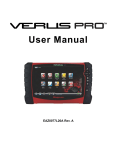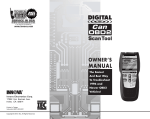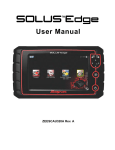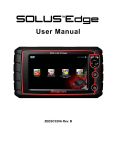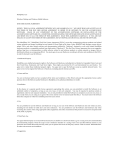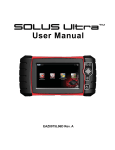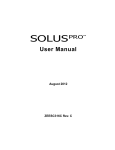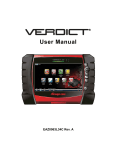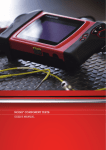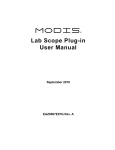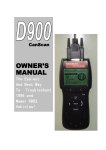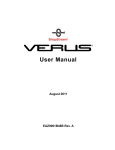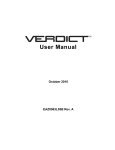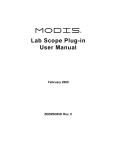Download User Manual
Transcript
User Manual August 2013 EAZ0075L06C Rev. A Trademarks Snap-on, ShopStream, and ShopStream Connect, are trademarks of Snap-on Incorporated. All other marks are trademarks or registered trademarks of their respective holders. Copyright Information ©2013 Snap-on Incorporated. All rights reserved. Disclaimer of Warranties and Limitation of Liabilities The information, specifications and illustrations in this manual are based on the latest information available at the time of printing. While the authors have taken due care in the preparation of this manual, nothing contained herein: • Modifies or alters in any way the standard terms and conditions of the purchase, lease, or rental agreement under the terms of which the equipment to which this manual relates was acquired. • Increases in any way the liability to the customer or to third parties. Snap-on reserves the right to make changes at any time without notice. IMPORTANT: Before operating or maintaining this unit, please read this manual carefully paying extra attention to the safety warnings and precautions. Visit our websites at: http://diagnostics.snapon.com (North America) www1.snapon.com/diagnostics/uk (United Kingdom) snapontools.com.au (Australia and New Zealand) For Technical Assistance Call: 1-800-424-7226 (North America) +44 (0) 845 601 4736 (United Kingdom) 1800-810-581(Australia and New Zealand) E-mail: [email protected] (North America) [email protected] (United Kingdom) [email protected] (Australia and New Zealand) For technical assistance in all other markets, contact your selling agent ii Safety Information For your own safety and the safety of others, and to prevent damage to the equipment and vehicles upon which it is used, it is important that the accompanying Important Safety Instructions be read and understood by all persons operating, or coming into contact with, the equipment. We suggest you store a copy near the unit in sight of the operator. This product is intended for use by properly trained and skilled professional automotive technicians. The safety messages presented throughout this manual are reminders to the operator to exercise extreme care when using this test instrument. There are many variations in procedures, techniques, tools, and parts for servicing vehicles, as well as in the skill of the individual doing the work. Because of the vast number of test applications and variations in the products that can be tested with this instrument, we cannot possibly anticipate or provide advice or safety messages to cover every situation. It is the automotive technician’s responsibility to be knowledgeable of the system being tested. It is essential to use proper service methods and test procedures. It is important to perform tests in an appropriate and acceptable manner that does not endanger your safety, the safety of others in the work area, the equipment being used, or the vehicle being tested. It is assumed that the operator has a thorough understanding of vehicle systems before using this product. Understanding of these system principles and operating theories is necessary for competent, safe and accurate use of this instrument. Before using the equipment, always refer to and follow the safety messages and applicable test procedures provided by the manufacturer of the vehicle or equipment being tested. Use the equipment only as described in this manual. Read, understand and follow all safety messages and instructions in this manual, the accompanying safety manual, and on the test equipment. Safety Message Conventions Safety messages are provided to help prevent personal injury and equipment damage. All safety messages are introduced by a signal word indicating the hazard level. '$1*( 5 Indicates an imminently hazardous situation which, if not avoided, will result in death or serious injury to the operator or to bystanders. :$51 ,1* Indicates a potentially hazardous situation which, if not avoided, could result in death or serious injury to the operator or to bystanders. &$87,21 Indicates a potentially hazardous situation which, if not avoided, may result in moderate or minor injury to the operator or to bystanders. iii Safety Information Important Safety Instructions Safety messages contain three different type styles. • Normal type states the hazard. • Bold type states how to avoid the hazard. • Italic type states the possible consequences of not avoiding the hazard. An icon, when present, gives a graphical description of the potential hazard. Example: :$51 ,1* Risk of unexpected vehicle movement. • Block drive wheels before performing a test with engine running. A moving vehicle can cause injury. Important Safety Instructions For a complete list of safety messages, refer to the accompanying safety manual. SAVE THESE INSTRUCTIONS iv Contents Chapter 1: Using This Manual ................................................................................................... 3 Conventions.................................................................................................................................. 3 Bold Text ................................................................................................................................ 3 Symbols ................................................................................................................................. 3 Terminology ........................................................................................................................... 4 Notes and Important Messages ............................................................................................. 4 Procedures............................................................................................................................. 4 Chapter 2: Introduction.............................................................................................................. 5 Functional Description .................................................................................................................. 5 Technical Specifications ............................................................................................................... 7 Control Keys ................................................................................................................................. 8 Accept (Y/a) Key ................................................................................................................... 8 Directional Keys ..................................................................................................................... 8 Cancel (N/X) Key ................................................................................................................... 9 S (Shortcut) Key..................................................................................................................... 9 Power Key.............................................................................................................................. 9 Power Sources ............................................................................................................................. 9 Internal Battery Pack.............................................................................................................. 9 AC/DC Power Supply........................................................................................................... 10 Vehicle Power ...................................................................................................................... 10 The Stand ................................................................................................................................... 10 Chapter 3: Getting Started....................................................................................................... 11 Powering Up ............................................................................................................................... 11 Home Screen.............................................................................................................................. 11 Home Screen Buttons .......................................................................................................... 12 The Demonstration Program................................................................................................ 13 Powering Down .......................................................................................................................... 13 Emergency Shutdown .......................................................................................................... 13 Chapter 4: Navigation .............................................................................................................. 14 Screen Layout ............................................................................................................................ 14 Title Bar................................................................................................................................ 14 Toolbar ................................................................................................................................. 15 Main Body ............................................................................................................................ 16 Screen Messages....................................................................................................................... 17 Loading and Connecting Messages..................................................................................... 17 Confirmation Messages ....................................................................................................... 17 Warning Messages .............................................................................................................. 17 Error Messages.................................................................................................................... 17 Chapter 5: Scanner................................................................................................................... 18 Vehicle Identification................................................................................................................... 18 Alternative Vehicle Identification .......................................................................................... 20 1 Contents Connecting to a Vehicle.............................................................................................................. 20 Cables .................................................................................................................................. 21 No Communication Message ............................................................................................... 21 Operations .................................................................................................................................. 22 Codes Menu......................................................................................................................... 23 Data Display......................................................................................................................... 25 Functional Tests................................................................................................................... 32 Troubleshooter ..................................................................................................................... 33 Exiting the Scanner .................................................................................................................... 33 Chapter 6: OBD-II/EOBD .......................................................................................................... 34 OBD Health Check ..................................................................................................................... 34 Global OBD II Code Check .................................................................................................. 35 Global OBD II Clear Codes .................................................................................................. 36 Readiness Monitors ............................................................................................................. 36 Connector Information ......................................................................................................... 37 OBD Diagnose............................................................................................................................ 37 Start Communication ........................................................................................................... 38 Select Communication Protocol ........................................................................................... 42 Connector Information ......................................................................................................... 43 Chapter 7: Previous Vehicles and Data.................................................................................. 44 Vehicle History............................................................................................................................ 44 View Saved Data ........................................................................................................................ 45 Delete Saved Data ..................................................................................................................... 46 Chapter 8: Tools ....................................................................................................................... 47 Tools Menu................................................................................................................................. 47 Connect to PC...................................................................................................................... 47 Configure Shortcut Key ........................................................................................................ 48 System Information .............................................................................................................. 48 Settings ................................................................................................................................ 49 Chapter 9: Maintenance ........................................................................................................... 56 Cleaning and Inspecting the Scan Tool...................................................................................... 56 Cleaning the Touch Screen ................................................................................................. 56 Battery Service ........................................................................................................................... 56 Battery Safety Guidelines .................................................................................................... 57 Replacing the Battery Pack.................................................................................................. 57 Disposing of the Batteries .................................................................................................... 58 2 Chapter 1 Using This Manual This manual contains tool usage instructions. Some of the illustrations shown in this manual may contain modules and optional equipment that are not included on your system. Contact your sales representative for availability of other modules and optional equipment. 1.1 Conventions The following conventions are used. 1.1.1 Bold Text Bold emphasis is used in procedures to highlight selectable items such as buttons and menu options. Example: • Press the OK button. 1.1.2 Symbols Different types of arrows are used. The “greater than” arrow (>) indicates an abbreviated set of selection instructions. Example: • Select Tools > Connect-to-PC. The example statement abbreviates the following procedure: 1. Select Tools from the home screen. 2. Highlight Connect-to-PC on the Tools menu. 3. Select Connect-to-PC. The solid arrows (e, c, d, b) are navigational instructions referring to the four directions of the directional arrow keys. Example: • Press the down d arrow. 3 Using This Manual Conventions 1.1.3 Terminology The term “select” means highlighting a button or menu item and pressing the Accept, OK, Yes, or other similar button to confirm the selection. Example: • Select Brightness. The above statement abbreviates the following procedure: 1. Navigate to and highlight the Brightness selection. 2. Press the OK, or similar, button. 1.1.4 Notes and Important Messages The following messages are used. Notes A NOTE provides helpful information such as additional explanations, tips, and comments. Example: i NOTE: For additional information refer to... Important IMPORTANT indicates a situation which, if not avoided, may result in damage to the test equipment or vehicle. Example: IMPORTANT: Do not disconnect the data cable while the Scanner is communicating with the ECM. 1.1.5 Procedures An arrow icon in the left-margin area indicates a procedure. Example: z To change screen views: 1. Select the Graph icon. The dropdown menu displays. 2. Select an option from the menu. The screen layout changes to the format selected. 4 Chapter 2 Introduction The Scanner interfaces with the electronic control system of a vehicle to retrieve diagnostic trouble codes (DTCs), access serial data stream information, and command bi-directional tests. Various vehicle control systems, such as engine, transmission, and antilock brake system (ABS), are readily diagnosed using this scan tool. The Scanner is capable of graphing up to four live data parameters on a single screen, and also includes an extensive database of vehicle-specific troubleshooting information. This chapter describes the construction of the scan tool and addresses the use of the basic hardware controls and features in the following sections: • • • • • Functional Description Technical Specifications‚ on page 7 Control Keys‚ on page 8 Power Sources‚ on page 9 The Stand‚ on page 10 2.1 Functional Description 1 2 3 4 5 1— N/X Key (No, Cancel, or Return) 2— Y/a Key (Yes, Accept, or Continue) 3— Directional Key; left (e), right (c), up (b), down (d) 4— Shortcut Key 5— Power Key Figure 2-1 Front view 5 Introduction Functional Description 1 2 3 1— DC Power Supply Input Port 2— Battery Status Indicator LED (light emitting diode) 3— Mini USB Client Port 4— Micro secure digital (uSD) Card Port 5— Data Cable Port Figure 2-2 Top view 1 2 1— Collapsible Stand (closed) 2— Battery Compartment Cover Figure 2-3 Back view 6 4 5 Introduction Technical Specifications 2.2 Technical Specifications Touch Screen Resistive Touch Panel Display: 7.0 inch diagonal, Color LCD 800 x 480 resolution SWVGA Battery: Rechargeable lithium-ion battery pack Approximately 2 hour run time Approximately 5 hour charge time DC Jack Operating Voltage 10V and 28V DC Dimensions: Width: 11.2 inches 285.0 mm Height: 5.98 inches 151.8 mm Depth: 2.0 inches 50.9 mm Weight (including battery pack): 2.6 lbs. 1.18 kg Operating Temperature Range (ambient): At 0 to 90% relative humidity (non-condensing) 32 to 113°F 0 to 45°C Storage Temperature (ambient): At 0 to 70% relative humidity (non-condensing) –4 to 140°F –20 to 60°C Environmental Conditions: This product is intended for indoor use only This product is rated for Pollution Degree 2 (normal conditions) Power Supply: Supply Rating; 15 VDC, 2A 7 Introduction Control Keys 2.3 Control Keys There are five control keys located on the right side of the unit near the handgrip: Key Icon Description Accept, Yes Selects a menu or program, advances to the next screen, or provides a yes answer to a question on the screen. Directional, Arrows Moves the highlight on the display screen up, down, left, and right, as indicated by the arrows. Cancel, No Exits a menu or program, returns to the previous screen, or provides a no answer to a question on the screen. Shortcut A function key that can be programmed to provide a shortcut for performing a variety of routine tasks. Power, On/Off Turns the unit on and off. Also, press and hold for 5 seconds for emergency shutdown. All other tool operations are controlled through the touch screen. 2.3.1 Accept (Y/a) Key The Y/a key is used to do the following: • To select an item that was highlighted using the directional arrow keys. • To advance to the next screen in a series. • To answer “Yes” when a yes or no choice is given. 2.3.2 Directional Keys The directional, or arrow, keys move the cursor or highlight in their respective directions: • • • • Up (b) Down (d) Left (e) Right (c) 8 Introduction Power Sources 2.3.3 Cancel (N/X) Key The N/X key is used to do the following: • To exit a menu or program. • To close an open list and return to the previous menu. • To answer “No” when a yes or no choice is given. 2.3.4 S (Shortcut) Key Use the Shortcut key to quickly perform routine tasks, such as capturing an image of the current screen, with a single key stroke. The Shortcut, or S, key can be programmed to perform a number of functions. refer to Configure Shortcut Key‚ on page 48 for additional information. 2.3.5 Power Key The Power key powers up the tool, and turns it off. 2.4 Power Sources Your Display Device can receive power from any of the following sources: • Internal Battery Pack • AC/DC Power Supply • Vehicle Power 2.4.1 Internal Battery Pack The scan tool can be powered from the internal rechargeable battery pack. A fully charged standard battery pack provides sufficient power for about 2 hours of continuous operation. A multi-color LED on top of the unit (Figure 2-2) illuminates to indicate battery status. Interpret the LED as follows: • Green indicates the battery is fully charged • Red indicates the battery is being charged • Amber indicates a battery or battery charging issue. An amber LED is usually caused by excessive battery temperature (above 104°F/40°C), which disables charging. Allow the unit to cool down and make sure the ventilation ports are not obstructed if the LED is amber. 9 Introduction The Stand 2.4.2 AC/DC Power Supply The scan tool can be powered from a standard wall socket using the AC/DC power supply and power adapter. The jack on the output cable of the AC/DC power supply attaches to the DC power supply input port on top of the scan tool. Use only the AC/DC power supply provided. 2.4.3 Vehicle Power The scan tool receives power from the test vehicle when it is connected to a powered data link connector (DLC) with the data cable. All OBD-II/EOBD compliant vehicles are required to have battery power available on the DLC. If the scan tool does not power on when connected to an OBD-II/EOBD DLC, there may be a circuit problem on the vehicle. Check the green LED on the data cable (see Cables‚ on page 21 for additional information). If the LED is not illuminated, suspect a problem on the DLC power circuit. Certain vehicles do not provide vehicle power on the DLC. For these applications, a separate cable adapter and power cable are needed to power the unit. Optional data cable adapters are available for a number of vehicle manufacturers. Contact your sales representative for availability. The power cable connects to a port on the cable adapter. IMPORTANT: Never connect the optional power cable or the AC/DC power supply to the DC power supply input on top of the unit when the scan tool is communicating with a vehicle. 2.5 The Stand The built-in stand extends from the back of the unit to allow hands-free viewing. The stand clips into the unit for storage and pivots out so the display is at a 35 degree angle when in use. 10 Getting Started Chapter 3 Make sure the scan tool has a charged battery pack, is connected to a powered vehicle data link connector (DLC), or is connected to an AC power supply. 3.1 Powering Up Press the Power key on the front of the unit to switch the scan tool on. The system boots up, then opens the Home screen (Figure 3-1). 3.2 Home Screen The main body of the Home screen has four selectable buttons, one for each of the primary scan tool functions. These are explained briefly in the next section and discussed in detail in the Navigation chapter. 1 2 Scanner 1 Titlebar 2 Main Body OBD-II/EOBD Previous Vehicles & Data Figure 3-1 Sample Home screen 11 Tools Getting Started Home Screen The title bar, which runs across the top of the screen, provides information about the current screen or a description of the defined test vehicle. The title bar contains no selectable items. An icon at the right edge of the toolbar shows the status of the tool power supply: Table 3-1 Power supply icons Icon Definition Indicates power is being supplied by the internal battery pack Indicates the internal battery pack is weak and needs recharging Indicates power is being supplied by the AC/DC power supply Indicates power is being supplied by the vehicle Indicates the scan tool is actively communicating with a vehicle Indicates the scan tool is actively communicating with a personal computer 3.2.1 Home Screen Buttons The Home screen buttons allow you to select which of the primary scan tool functions to use. The table below gives brief descriptions of the button operations. Table 3-2 Home screen buttons Name Button Description Scanner Open a list of vehicle manufacturers to begin the process of establishing a communications link to the test vehicle. See "Scanner‚" on page 18 for details. OBD-II/EOBD Performs generic OBD-II/EOBD system tests without first identifying a test vehicle. See "OBD-II/EOBD‚" on page 34 for details. Previous Vehicle & Data Use to connect to a recently tested vehicle, or to access saved data files. See "Previous Vehicles and Data" for details. Tools & Setup Select to adjust tool settings to your personal preferences, to access scan tool system information, and perform other special operations. See "Tools" for details. Select from the Home screen buttons to begin testing. 12 Getting Started Powering Down 3.2.2 The Demonstration Program The Scanner demonstration program allows you to become familiar with many of the test capabilities of the tool without connecting to a vehicle. The demonstration contains actual data captured while driving a 2001 Chevrolet Tahoe. z To start the demonstration program: 1. From the Home screen, tap the Scanner icon. The manufacturer menu, which lists all of the makes available for testing, displays. 2. Tap the Demonstration button included on the manufacturer menu. 3. A screen advising you are in simulation mode displays, select Continue. IMPORTANT: Do not connect a vehicle to the scan tool while in the Demonstration mode. 4. Follow the on-screen instructions and select as needed until the confirmation screen displays. 5. Select OK on the confirmation screen to load the demonstration database. 6. Select OK from the Demo mode message screen. A systems menu, which shows all of the systems available for testing, displays 7. Select from any of the systems listed, then select from the submenus. i NOTE: There is also an OBD-II/EOBD demonstration, select “OBD Training Mode” in OBD-II/EOBD. 3.3 Powering Down Use the Power key to turn the scan tool off. IMPORTANT: All vehicle communication must be terminated before shutting down the scan tool. A warning message displays if you attempt to shut down while the Scanner is communicating with the vehicle. Forcing a shut down while communicating may lead to ECM problems on some vehicles. Exit vehicle communications before powering down. z To power off the unit: 1. Press N/X or Back until you reach the Home screen. A “stopping communication” message appears briefly before the Home screen displays. 2. Disconnect the Scanner Data Cable from the vehicle test connector. 3. Press the Power key. The Turn off dialog box displays. 4. Press Y/a to turn the power off, or press N/X to cancel and test a different vehicle. 3.3.1 Emergency Shutdown In case of emergency, press and hold the Power key for five seconds to force a shutdown. 13 Chapter 4 Navigation This chapter describes the scan tool screen layout, and to make selections using screen menus and buttons, and the various types of messages that display while using the tool. 4.1 Screen Layout Scan tool screens (Figure 4-1) typically include the following sections: 1 2 3 1— Title bar—shows test and tool status 2— Toolbar—contains test controls 3— Main body—displays menus and test data Figure 4-1 Sample scan tool screen 4.1.1 Title Bar The title bar at the top of the screen, provides basic information about current tool operating conditions. Title bar options vary depending upon vehicle make and model, what test is being performed or what menu is selected. Title bar information may include: • • • • The identification (ID) of the test vehicle The name of the active menu or database A power source indicator A vehicle communication indicator Depending upon what is being displayed in the main body of the screen, either the vehicle ID or the active menu is shown at the left side of the title bar. An icon at the far right side of the title bar indicates whether the tool is being powered by the internal battery pack, the test vehicle, or the AC/DC power supply. A communication icon displays to the left of the power source indicator whenever the scan tool is actively communicating with a vehicle or a personal computer. 14 Navigation Screen Layout 4.1.2 Toolbar The toolbar, located under the title bar, contains a number of selectable buttons that control tool functions. What buttons appear on the toolbar varies, as only buttons that are active or available for the current screen and test mode display. A brief description of common toolbar button operations are shown in Table 4-1. Additional buttons appear on the toolbar when special operations are available. These buttons are explained in the Operations chapter. Table 4-1 Data toolbar buttons (part 1 of 2) Button Icon Function Back Returns to the previously viewed screen. This button is always at the left-hand edge of the toolbar. Home Returns to the Home screen. This button is always alongside the Back button on the left of the toolbar. Pause Indicates live data from the vehicle is being displayed. Selecting pauses data collection. Record Indicates the data being displayed is paused and not being updated. Selecting resumes data collection. Clear Erases all the data in the buffer and begins a new recording. Selecting opens a confirmation message. Sort Determines the order in which the data parameters are listed on the screen. PID Triggering Opens a menu that allows you to set, arm, and clear threshold values that automatically trigger a data movie recording. Zoom Incrementally increases and decreases the scale of the data graphs. Custom Data List Opens a menu for selecting which parameters display in the data list. This button displays when viewing a data list. Graph Switches between parameter list and graph display modes. This button displays when viewing a data list. Lock/Unlock Locks or unlocks the highlighted parameter. This button displays when viewing a data list. Save Saves the current screen information, such as a Scanner movie, to tool memory. 15 Navigation Screen Layout Table 4-1 Data toolbar buttons (part 2 of 2) Button Icon Function Tools Opens the tools menu, which allows you to adjust basic tool settings. Previous Frame Moves back one frame at a time when viewing recorded or paused data. Hold the button down to keep moving back through the data. Next Frame Moves forward one frame at a time when viewing recorded or paused data. Hold the button down to keep moving forward through the data. Back 10 Frames Moves back 10 frames at a time when viewing recorded or paused data. Hold the button down to keep moving back through the data. Forward 10 Frames Moves forward 10 frames at a time when viewing recorded or paused data. Hold the button down to keep moving forward through the data. When a selectable item on the screen is highlighted, a yellow frame surrounds the item to indicate that it is in focus. 4.1.3 Main Body The main body of the screen is the lower portion, which displays either a menu of available tests or data from the vehicle. A vertical scroll bar appears along the right-hand edge of the main body when there is additional data either above or below what is currently on the screen (Figure 4-2). 1 2 3 4 5 1— Go to beginning 2— Go up 1 page 3— Slider (position indicator) 4— Go down 1 page 5— Go to end Figure 4-2 Sample scroll bar 16 Navigation Screen Messages Tap the arrowheads at the ends of the scroll bars to move through the data in the direction of the arrow one page at a time. Selecting an arrowhead that points to a line moves you directly to the beginning or end of the data. The slider in the center portion of the scroll bar indicates the relative position of the current screen to the total available data. 4.2 Screen Messages There are four types of on-screen message: • • • • Loading and connecting Confirmations Warnings Errors 4.2.1 Loading and Connecting Messages Loading and connecting messages display when the scan tool is performing an internal operation, such as loading a database, initiating a test, or establishing communications with the vehicle. The message automatically clears once the internal operation is complete. 4.2.2 Confirmation Messages Confirmation messages inform you when you are about to perform an action that cannot be reversed or when an action that requires your confirmation to continue has been initiated. When a response is not required, the message displays briefly, then disappears. 4.2.3 Warning Messages Warning messages inform you when completing the selected action may result in an irreversible change or loss of data. 4.2.4 Error Messages Error messages inform you when a system or procedural error has occurred. Examples of possible errors include: • A cable is disconnected. • A peripheral, such as a printer is powered off. 17 Chapter 5 Scanner The Scanner establishes a data link to the electronic control systems of the vehicle being serviced. This allows you to retrieve diagnostic trouble codes (DTCs) view live data parameters, and perform tests. Scanner testing requires connecting the scan tool to the test vehicle using the data cable and test adapters. On screen instructions tell you how to connect the Scanner. Additional connection information can be found in the appropriate vehicle communication software manual for the test vehicle. Vehicle communication software manuals are available on the internet at: http://diagnostics.snapon.com/usermanuals. 5.1 Vehicle Identification The Scanner information presented is provided by the ECM of the vehicle. Therefore, certain attributes of the vehicle must be entered into the scan tool to ensure the test data displays correctly. This vehicle identification sequence is menu driven, simply follow the screen prompts to make a series of choices. Each selection advances you to the next screen. Exact procedures may vary by the make, model, and year of the test vehicle. z To identify a vehicle for Scanner testing: 1. Tap the Scanner button on the Home screen. A list of manufactures displays (Figure 5-1). Figure 5-1 Sample manufacturer list The list includes Demonstration, which opens the Demonstration program (see The Demonstration Program, on page 13). 2. Select the vehicle manufacturer from the list. 18 Scanner Vehicle Identification A model year menu displays. 3. Select the vehicle year from the menu. A list of vehicle types or models displays. Several selections may be required to complete the vehicle identification, follow the screen prompts to enter the required information. A confirmation screen displays once all the required data has been entered (Figure 5-2). Figure 5-2 Sample confirmation dialog box 4. From the Confirm Vehicle screen select: a. OK to continue. b. Cancel to return to the engine list. When Yes is selected list of systems available for testing on the identified vehicle displays. 5. Select a system from the list to continue (Figure 5-3). Figure 5-3 Sample available systems list 19 Scanner Connecting to a Vehicle i NOTE: Only the systems available for testing on the identified vehicle are included in the list. The identification sequence is now complete. 5.1.1 Alternative Vehicle Identification Occasionally, you may identify a test vehicle that the Scanner does not recognize, the database does not support, or has some unique characteristics that prevent it from communicating with the Scanner through the normal channels. In these instances, a menu of alternate choices displays. Alternate choices allow you to establish communication with the vehicle by other means. The following alternatives are available: • Manufacturer—allows you to begin diagnosing by first selecting from a list of makes. • OBDII/EOBD—allows you to perform generic OBD-II or EOBD tests. See OBD-II/EOBD, on page 34 for additional information. • Select by Database—allows you to begin the vehicle identification by first selecting which database to load. Selecting opens a menu of available databases. 5.2 Connecting to a Vehicle Instructions for connecting the Scanner to the vehicle with the data cable are shown once a selection is made from the list of systems available for testing (Figure 5-4). Figure 5-4 Sample vehicle connection message If an optional cable adapter is needed, the instructions tell you which one to use, and also where to locate the vehicle diagnostic connector to perform the selected tests. 20 Scanner Connecting to a Vehicle 5.2.1 Cables One of two data cables, one for OBD-II/EOBD compliant vehicles and an optional one for non-OBD-II/EOBD models, is used to connect the scan tool to the test vehicle. The 26-pin end of either cable attaches to the data cable port on the top of the scan tool. The connector is secured with captive screws. The 16-pin end of the OBD-II/EOBD cable directly plugs into the data link connector (DLC) of the test vehicle. With the non-OBD-II/EOBD cable, a cable adapter attaches to the 15-pin end of the cable and the adapter then plugs into the vehicle test connector. On-screen instructions on the scan tool tell you which cable, and adapter if needed, to use once a vehicle has been identified. The screen message also includes the location of the vehicle diagnostic connector the cable attaches to for testing the selected system. A replaceable 7.5 amp blade-type fuse is installed in the vehicle connector end of the cable to protect the unit from high circuit voltage and current. A green LED, also on the vehicle connector end of the cable, illuminates whenever power is supplied to the cable. An LED that fails to illuminate indicates either a problem on the vehicle power circuit or a blown data cable fuse. All OBD-II/EOBD vehicles have vehicle battery power (B+) available on the DLC. The optional auxiliary power cable supplies power for testing non-OBD-II/EOBD models that do not have B+ available on the diagnostic connector. The optional cable and adapters are required for testing non-OBD-II/EOBD models. z To connect the data cable to the vehicle: 1. Follow the on-screen instructions for connecting to the vehicle (Figure 5-4). 2. Once connected, select Continue. The Scanner establishes communication then displays a list of available tests. If the Scanner is unable to establish a communications link, a “no communications” message displays. 3. Select from the available tests to open a submenu of test options. 5.2.2 No Communication Message When the screen displays a “no communication” message, it means the scan tool and the vehicle control module cannot communicate with each other for some reason. The following conditions cause a “no communication” message to display: • • • • • • • The Scanner is unable to establish a communication link with the vehicle. You selected a system for testing that the vehicle is not equipped with. There is a loose connection. There is a blown vehicle fuse. There is a wiring fault on the vehicle. There is a circuit fault in the data cable or adapter. Incorrect vehicle identification was entered. Refer to the Vehicle Communication Software manuals for manufacturer-specific problems. 21 Scanner Operations 5.3 Operations The Scanner allows you to establish a data link to the electronic control systems of the vehicle being serviced in order to view live data parameters and perform tests. Data may be available from multiple systems, such as engine, transmission, antilock brake system (ABS), and others. Functional tests, troubleshooting tips, and trouble code information are typically available. The Scanner has two main functions: 1. Scanner—provides access to vehicle systems to perform functions such as reading codes, viewing data, and conducting functional tests. 2. Fast-Track Troubleshooter—provides the diagnostic power of Fast-Track Troubleshooter, a database of experience based information developed by master technicians. After a system is selected and the Scanner establishes communication with the vehicle, a Scanner Main menu, which lists available tests, displays. Figure 5-5 Sample Scanner Main menu Main menu options vary slightly by the year, make, and model of the test vehicle. The main menu may include: • Data Display— displays data parameter information from the vehicle control module. Selecting may open a submenu of viewing options. • Codes Menu—displays diagnostic trouble code (DTC) records from the vehicle control module. Selecting may open a submenu of viewing options. • Clear Codes—erases DTC records and other data from the ECM. This selection is found on a Codes submenu for some models. • Functional Tests—provides specific subsystem and component tests. The tests vary depending on the manufacturer and model. • Actuator Tests—similar to functional tests, checks the operation of certain actuators, such as solenoid valves and relays. • Memory Resets—allows you to reprogram adaptive values for certain components after making repairs. Selecting opens a submenu. These options are found on the Functional Tests Menu for some models. 22 Scanner Operations • System Tests—provides specific subsystem testing. Performing these tests is similar to functional tests. • Generic Functions—lets you access certain available Generic OBD II functions from a proprietary menu (1996 and newer vehicles only). • Troubleshooter—provides step-by-step procedures, integrating parameter data and retrieving trouble codes when appropriate, for specific symptoms of the identified vehicle. z To perform a Scanner test 1. Launch the Scanner—Tap Scanner on the Home screen. 2. Identify the vehicle—Identify the test vehicle by selecting from the menu options. 3. Select the system—Select the system to be tested from the systems menu. 4. Connect the data cable to the vehicle—Follow the on-screen connection instructions to connect the scan tool unit to the test vehicle. 5. Select the test from the Scanner main menu—Select the desired test. 5.3.1 Codes Menu This selection may appear as Codes, Codes Menu, Codes Only, Codes (No Data), Service Codes or something similar on the menu. Selecting opens a list of data parameter viewing options that includes: • Display Codes • Clear Codes, on page 24 • Freeze Frame/Failure Records, on page 24 Display Codes Selecting opens either a list of diagnostic trouble codes (DTCs) stored in the selected electronic control module (ECM), or a submenu of DTC viewing options. Submenu options include: • Trouble Code Information—opens a list of codes in ECM memory • History Codes—opens a list codes whose symptoms are not currently present. History codes indicate an intermittently occurring problem. • Failed This Ignition—opens a list of codes that set during the current ignition cycle. • MIL SVS or Message Requested—displays ECM requests to turn on the malfunction indicator lamp (MIL) or service vehicle soon (SVS) lamp, or display a driver information alert. • Last Test Failed—displays a complete list of failed tests. • Test Failed Since Code Cleared—displays a list of tests that failed since the last time codes were cleared from ECM memory. A code list includes the DTC and a brief description (Figure 5-6). 23 Scanner Operations Figure 5-6 Sample code list Clear Codes The Scanner clears emissions-related codes from the control module memory on some vehicles. If this function is not available on the test vehicle, Clear Codes does not appear as a menu option. i NOTE: Clear Codes is also available from OBD-II Health Check (see OBD Health Check, on page 34). z To clear codes: 1. Select Clear Codes from the Codes Menu. A confirmation message displays. 2. Make sure any conditions shown on the confirmation message are met, then select Yes. A “codes cleared” message displays once the operation is complete. 3. Select Continue to return to the Codes Menu. IMPORTANT: Clearing codes erases all temporary ECM information, including Freeze Frame/Failure Records. Make sure no vital information will be lost before clearing codes. Freeze Frame/Failure Records This selection displays the DTC that was set, along with corresponding data, when the ECM commanded the malfunction indicator lamp (MIL) to turn on. 24 Scanner Operations 5.3.2 Data Display Select Data to view live datastream parameters from the vehicle ECM. In data display mode the screen has a toolbar and a main body (Figure 5-7). Figure 5-7 Sample data display screen The buttons on the toolbar operate as shown in Table 4-1 on page15 while viewing data. During data display the main body of the screen is divided into two columns; the left-hand column has a description of the parameter and the right-hand column shows the parameter value or state. Parameters are listed in the order in which they are transmitted by the ECM, so expect variations between years, makes, and models. Up to three parameters can be locked, or fixed, at the top of the list. Locked parameters do not change as you scroll through the parameter list. The Lock/Unlock button on the toolbar selects which parameters are fixed (see Locking Parameters, on page 28). Pausing Data Collection You may “pause” the collection of data from the vehicle control module to more closely examine it. When data is paused, all of previous frames of data stored in the scan tool memory buffer are available for review. z To pause data collection: 1. While viewing live data, touch the Pause button. On the toolbar, the Record button replaces the Pause button and the Previous Frame and Next Frame buttons display. A frame counter displays at the top of the main body of the screen, and a vertical line indicates your position when in the graph mode (Figure 5-8). 25 Scanner Operations 1 2 3 4 5 1— Previous Frame button 2— Next Frame button 3— Record button 4— Frame counter (current frame/total frames) 5— Position indicator Figure 5-8 Sample paused frame of data 2. Scroll to review the data in the frame. 3. To switch frames, touch Previous Frame or Next Frame. Each button touch moves one frame in the selected direction. z To resume collecting data: • Touch the Record button. The display changes to live data and the Pause icon is shown on the toolbar. i NOTE: The Shortcut button can be set to perform the Pause/Play function. See Configure Shortcut Key, on page 48 for additional information. Sorting Data The Sort button on the toolbar allows you to arrange the parameter list three ways: • Factory Sort—lists parameters in the order they are transmitted by the ECM • A-Z Sort—lists parameters alphabetically in ascending order • Z-A Sort—lists parameters alphabetically in descending order 26 Scanner Operations z To sort the data list: 1. Select the Sort button on the toolbar. 2. Select from the dropdown menu using either the touch screen or the arrow and Y/a keys. i NOTE: Any locked parameters are unlocked whenever a selection is made from the Sort button. Customizing the Data List The Custom Data List button on the Scanner Toolbar is used to determine which specific parameters display. Minimizing the number of parameters on the data list allows you to focus on any suspicious or symptom-specific data parameters. You can add or remove most parameters from the list. Certain vital parameters cannot be removed. These appear in gray at the top of the list along with a lock icon, and they cannot be selected. i NOTE: Limiting the number of parameters that displays to those that apply to a particular situation results in a faster data refresh rate, and reduces the amount of memory used for saved files. z To create a custom data list: 1. Tap the Custom Data List button on the toolbar to select it. The data selection screen displays and two new buttons appear on the toolbar. Check marks to the left of the parameter description indicates which parameters are selected for display. A second smaller check box indicates a parameter that is locked. The toolbar buttons provide options for selecting and deselecting which parameters to include or remove from the custom data list: Button Description Select/Deselect, use to mark individual parameters to hide or display. Select All/Deselect All, use to hide or display all of the parameters in the list. Any locked parameters cannot be hidden. 2. Create a custom data list by touching the parameters to include. A parameter that displays has a check mark alongside the name, a parameter that does not display does not: a. Touching the Select All/Deselect All button immediately changes all of the parameters to the same condition, a second touch changes them all back. b. Touching the Select/Deselect button activates it. Now you can add or remove parameters by touching individual entries in the list. Keep the following in mind: – – – – Items at the top of the list that cannot be highlighted are locked and cannot be turned off. Use the Select All button to display the complete list. Use the Deselect All button to remove all of the highlights. Use the Cancel button to return to the data display. 3. Select OK to display the updated data list. 27 Scanner Operations Changing Screen Views Selecting the Graph button opens a dropdown menu of options: • • • • PID List 1 Graph 2 Graph 4 Graph The PID (parameter identification) List view is a 2-column display with the name of the parameters in the left column and their current values in the right column (Figure 5-7). The 1, 2, and 4 Graph views divide the screen horizontally to simultaneously display data graphs for the indicated number of parameters (Figure 5-9). Use the scroll bar or the up (b) and down (d) keys to view other parameters. Figure 5-9 Sample 4 Graph view screen Any previously set conditions, such as held data or locked lines of data, remain in effect when the screen view is changed. Locking Parameters Use the Lock/Unlock button to lock selected lines of the data in place and prevent them from scrolling, or to release previously locked lines of data. Up to three lines of data may be held at a time. This feature allows you to position related parameters together, making it easier to monitor their values and spot inconsistencies. Locked parameters display as the top frames on the main body of the display screen, as well as at their usual position within the data list (Figure 5-10). A lock icon appears to the left of the parameter name to indicate it is locked. 28 Scanner Operations z To lock parameters: 1. Highlight the parameter to be locked. 2. Tap the Lock/Unlock button on the toolbar to lock it. A copy of the locked parameter is now shown at the top of the data list, and a lock icon appears alongside the parameter name. 3. Highlight and select additional parameters to lock. Up to three parameters can be locked at a time. Once locked, a parameter remains locked until it is manually unlocked or communication with the vehicle stopped. Figure 5-10 Sample locked parameters i NOTE: If three parameters are locked, one of them must first be unlocked before another parameter can be locked. z To unlock parameters: 1. Scroll through the data list and highlight the parameter to be unlocked, or released. 2. Tap the Lock/Unlock button on the toolbar. The released parameter and the lock icon disappear from the list at the top of the data list. 3. Repeat Step 1 and Step 2 to release other parameters if needed. Saving The Save button is used to record movies of vehicle datastream values. Saving helps when trying to isolate an intermittent problem or to verify a repair during a road test. Saved files also provide documentation that helps you explain driveability problems to your customers. A number of data movies can be stored, which can later be opened by selecting the Previous Vehicles and Data button on the home screen. Saved files can also be downloaded from the scan tool to a personal computer (PC) through the Mini USB port. Once connected to the PC, SOLUS Ultra files can be printed, transferred, and 29 Scanner Operations copied using ShopStream Connect. ShopStream Connect is a PC application that creates an interface between the scan tool and a PC. The ShopStream Connect application is a free download available at: http://diagnostics.snapon.com/SSC. z To save a movie: • Select Save. A save movie dialog box displays while data is being saved. The movie is saved when the message box disappears. Figure 5-11 Sample save dialog box i NOTE: The Shortcut key can be programmed to perform the Save Screen or Save Movie function. See Configure Shortcut Key, on page 48 for details. Setting Trigger Levels The PID Trigger button on the toolbar allows you to configure the scan tool to automatically capture data when a parameter value crosses a threshold value. When triggering is armed, a “trigger event” pauses data collection and records a data movie. Triggered movies are similar to an OBD-II/EOBD freeze-frame event, but include much more information. Selecting the PID Trigger button opens a menu that includes: • Set Trigger—establishes upper and lower signal values to initiate an event capture for the highlighted parameter. • Arm Trigger—activates the scan tool to capture an event when the signal crosses a threshold value. • Clear All Triggers—deletes all previously set trigger levels. 30 Scanner Operations If triggers are set the menu options are: • Clear Trigger—deletes set trigger levels for the highlighted parameter. • Disarm Trigger—de-activates event capture capability. • Clear All Triggers—deletes all previously set trigger levels. z To set trigger levels: 1. Highlight the parameter to be used for triggering the recording. 2. Tap the PID Trigger button. 3. Select Set Trigger from the dropdown menu. A graph of the highlighted parameter with a trigger toolbar above it fills the main body of the screen. The trigger level line displays as a solid line running horizontally across the data graph (Figure 5-12). An upper and lower trigger level must be set, the upper level is set first. Figure 5-12 Sample trigger set screen 4. Tap the plus (+) and minus (–) buttons on the toolbar, or use the up b and down d arrow buttons to position the upper trigger level to where you want it on the graph. 5. Tap a on the toolbar, or press the Y/a key, to set the upper threshold. A lower trigger level line now appears at the mid-point of the graph. 6. Tap the plus (+) and minus (–) buttons on the toolbar, or use the up b and down d arrow keys to position the lower trigger level line to where you want it on the graph. 7. Tap a on the toolbar, or press the Y/a key, to set the lower threshold. 8. Press Y/a once the lower trigger is set to exit. The display returns to the live data view and the trigger points appear as horizontal lines across the designated parameter graph. Repeat this procedure to establish trigger points for other parameters if desired. Once armed, any data points that register outside of your set conditions pause data collection and save a recording. i NOTE: Only three parameters can have trigger levels set at one time, but only one of the conditions needs to be satisfied for triggering to occur. 31 Scanner Operations z To arm triggers: 1. Tap the PID Trigger button on the toolbar. 2. Select Arm Triggers from the dropdown menu. The trigger lines on the data graphs change color to indicate an armed condition. Triggers for all of the graphs are armed simultaneously. Once triggering is armed, it remains in that state until you switch it off. If trigger settings are modified or are added for other parameters, they are armed as soon as you exit the setting screen. 5.3.3 Functional Tests The Functional Tests selection is used to access vehicle-specific subsystem and component tests. Available tests vary by manufacturer, year, and model. Only the tests available for the identified vehicle display in the menu. There are four general types of functional test: • Information Tests—these are read-only tests, like selecting “VIN” from a Functional Tests menu to display the VIN of the identified vehicle. • Toggle Tests—these tests switch a component, such as a solenoid, relay, or switch, between two operating states. • Variable Control Tests—these tests command a certain value for a system or component, such as varying spark timing in 1° increments or EGR valve duty cycle in 10% increments. • Reset Tests—these tests reset the adaptive, or learned, values that are stored in the ECM • Scripted Tests—these tests are software routines that place the vehicle into special operating modes for performing certain repairs, such as bleeding brakes with ABS. Selecting Functional Tests opens a menu of test options that varies by make and model. Selecting a menu option either activates the test or opens a submenu of additional choices. Follow all screen instructions while performing tests. How and what information is presented on the screen varies according to the type of test being performed. Some toggle and variable control tests display functional test controls at the top of the screen with datastream information below. Functional test controls allow you manipulate the test signal as shown in Table 5-1. Table 5-1 Sample functional test control buttons Name Button Description OK Activates the test. Cancel Cancels the test. Minus Switches an item off or low, or incrementally reduces a variable signal. Plus Switches an item high or on, or incrementally increases a variable signal. 32 Scanner Exiting the Scanner 5.3.4 Troubleshooter Fast-Track® Troubleshooter is a database of experience-based information. The database is composed of validated real-world repair strategies that have been compiled by top-notch technicians since 1988. The Troubleshooter system simplifies the diagnosis process, as it contains information on virtually all common diagnostic trouble code (DTC) problems and driveability symptoms for most vehicles covered by the vehicle communication software. Information is organized into a series of diagnostic tips that are designed to quickly lead you to the root cause of a particular problem. The tips are vehicle-specific, which means only tips that relate to the identified vehicle are presented. Selecting opens a menu that typically includes: • Code Tips—provides detailed information on setting conditions, testing, and interpreting test results for specific codes. • Symptom Tips—provides diagnostic tests and procedures based on vehicle operation. • Time Savers—provides supplemental information, such as firing order and #1 cylinder location, that may be needed to make a diagnosis. • Common Problems—provides advice and remedies for certain “pattern failures” that have been experienced on vehicles of the same model. • Tests and Procedures—explains how to perform certain tests on the specific test vehicle. Some tips provide specifications and installation information as well. • Fast-Track Data Scan (Normal Values)—contains information and guidelines on how to quickly validate data readings for certain sensors and actuators, live data values are provided for comparison. Certain live data parameter values display directly within the tip when performing Troubleshooter tests and procedures. A tip may also contain a hyperlink to a another test or procedure or a supplemental operation, such as Clear Codes. Hyperlinks are shown in blue, and tapping them opens the link. 5.4 Exiting the Scanner The Scanner remains open as long as there is an active communication link with the vehicle. You must interrupt this communication link in order to exit from Scanner tests and power down the scan tool. A warning message displays if you attempt to shut down while the Scanner is communicating with the vehicle. i z NOTE: Damage to the vehicle electronic control module (ECM) may occur if communication is disrupted. Make sure the data cable is properly connected at all times during testing. Exit all tests before disconnecting the data cable or powering down the tool. To exit the Scanner: 1. From an active screen, select Exit from the Scanner Toolbar to return to the Systems Menu. 2. From the Systems Menu, select Back from the Scanner data menu. A “stopping communications” message briefly displays followed by the Scanner main menu. Now, the Scanner is no longer communicating with the vehicle and it is safe to return to the Home screen and power down the scan tool. 33 Chapter 6 OBD-II/EOBD This Home screen option allows you to access Generic OBD-II/EOBD Scanner tests without completing a vehicle identification. This presents a quick way to check for diagnostic trouble codes (DTCs), isolate the cause of an illuminated malfunction indicator lamp (MIL), check monitor status prior to emissions certification testing, verify repairs, and perform a number of other emissionsrelated services. OBD-II/EOBD is also used for testing OBD-II compliant vehicles that are not included in the Scanner databases. OBD-II/EOBD is a Scanner function, and the scan tool must be connected to the test vehicle and communicating with it. Keep in mind, this function provides generic OBD-II information only. Select from the Vehicle Manufacturers Menu for enhanced OBD-II functions. Selecting OBD-II/EOBD on the Home screen opens a menu with two options: • OBD Health Check • OBD Diagnose 6.1 OBD Health Check The OBD-II Health Check offers a way to quickly check for and clear generic DTCs, and to check readiness monitors for emissions testing. Selecting opens a connection message, then a submenu of test options (Figure 6-1). Figure 6-1 Sample OBD Health Check menu 34 OBD-II/EOBD OBD Health Check 6.1.1 Global OBD II Code Check Global OBDII Code Check displays stored emission related generic DTCs reported by the ECM. Selecting this option opens a submenu with two choices: Codes and Pending Codes. Selecting either option opens a code list. Figure 6-2 Sample code list Codes The Codes option displays a list of current emission related DTCs. OBD-II/EOBD Codes have a priority according to their emission severity, with higher priority codes overwriting lower priority codes. The priority of the code determines the illumination of the MIL and the code erase procedure. Vehicle manufacturers have implemented the ranking differently, so there are differences between makes. Pending Codes The purpose of this service is to enable the scan tool to obtain “pending” or maturing diagnostic trouble codes. These are codes whose setting conditions were met during the last drive cycle, but need to be met on two or more consecutive drive cycles before the DTC actually sets. Use this service following a vehicle repair and code clearing procedure to verify test results after a single drive cycle. • If a test failed during the drive cycle, the DTC associated with that test is reported. If the pending fault does not occur again within 40 to 80 warm-up cycles, the fault is automatically cleared from memory. • Test results reported by this service do not necessarily indicate a faulty component or system. If test results indicate another failure after additional driving, then a DTC is set to indicate a faulty component or system, and the MIL is illuminated. Refer to and the Global OBD Vehicle Communication Software Manual for additional information. 35 OBD-II/EOBD OBD Health Check 6.1.2 Global OBD II Clear Codes This option is used to clear all emission related diagnostic data, such as DTCs, freeze frame data, and test results, from the memory of the selected ECM. Although OBD-II/EOBD displays generic OBD-II/EOBD data only, clearing codes erases all of the stored data, including any enhanced codes and freeze frame information. A confirmation screen displays when the clear codes option is selected to prevent accidental loss of data. Select Yes from the confirmation screen to continue. Refer to the Global OBD Vehicle Communication Software Manual for additional information. 6.1.3 Readiness Monitors Use to check the readiness status of the monitoring system. An OBD-II /EOBD system checks the status of emission-related subsystems by running continuous or periodic tests. Two viewing options are available once Readiness Monitors is selected: • Monitors Complete Since DTC Cleared—displays the status of all monitors that have run since the last time DTCs were erased. • Monitors Complete This Cycle—displays the status of the monitors that ran during the current drive cycle only. Select either option and test results are shown in the data viewer (Figure 6-3). Figure 6-3 Sample readiness monitor test report Scroll to view the entire list of Readiness Monitors to ensure that all tests are complete. It is possible to save the monitor report as part of the vehicle records. Select Save from the toolbar and follow the screen prompts. 36 OBD-II/EOBD OBD Diagnose 6.1.4 Connector Information This option opens a database of vehicle diagnostic connector locations that includes most makes and models. The menu driven interface leads you quickly to the difficult to find test connector. z To locate a vehicle diagnostic connector: 1. Select Connector Information from the System menu. A list of vehicle manufacturers displays. 2. Select a manufacturer from the list. A list of models available from the selected manufacturer displays. 3. Select a model from the list. If a cable adapter is needed, which one and how to connect it displays. 4. Select Continue. Information on where to locate the vehicle diagnostic connector displays. Figure 6-4 Sample diagnostic connector location 5. Select Continue to return to the System menu. 6.2 OBD Diagnose Selecting OBD Diagnose opens a menu with the following options: • Start Communication—initiates a test session • Select Communication Protocol—establishes which communication protocol to use • Connector Information—provides data link connector (DLC) location details 37 OBD-II/EOBD OBD Diagnose 6.2.1 Start Communication Use the following procedure to begin an OBD-II/EOBD test session: z To perform an OBD-II/EOBD Test: 1. Select Start Communications from the OBD-II/EOBD menu. A vehicle type options list displays: – 12V Light Duty Vehicle – 24V Heavy Duty/Goods Vehicle 2. Select an option from the vehicle type list. A connection message displays. 3. Connect the data cable to the test vehicle. 4. Select Continue. The scan tool establishes a communication link with the test vehicle, then displays an information screen that shows how many control modules were detected, which ECM is communicating, and which communication protocol is being used (Figure 6-5). Figure 6-5 Sample protocol information screen 5. Select Continue. A Select Service menu of available tests displays, options include: – – – – – – – – – – Readiness Monitors‚ on page 39 MIL Status‚ on page 39 ($01) Display Current Data‚ on page 39 ($02) Display Freeze Frame Data‚ on page 40 ($03) Display Trouble Codes‚ on page 40 ($04) Clear Emissions Related Data‚ on page 40 ($05, 06, 07) Display Test param./Results‚ on page 41 ($08) Request Control of On-board System‚ on page 41 ($09) Read Vehicle Identification‚ on page 41 ($0A) Emission Related DTC with Permanent Status‚ on page 42 38 OBD-II/EOBD OBD Diagnose IMPORTANT: All service modes are not supported by all vehicles, so the available menu selections will vary. 6. Select a test to continue. Readiness Monitors Use this menu item to check the readiness of the monitoring system. If a monitor system is not supported, it is not displayed. Scroll, if needed, to view the entire list of monitors (Figure 6-3). Selecting Readiness Monitors opens a submenu with two choices: • Monitors Complete Since DTC Cleared—displays the results of all monitor tests that have run since the last time the electronic control module (ECM) memory was cleared. • Monitors Complete This Cycle—displays only the results of monitor tests that ran during the current drive cycle, they reset when the ignition is switched off. MIL Status This item is used to check the current condition of the malfunction indicator lamp (MIL). Additional information, such as which ECM commanded the MIL on and the distance driven while the MIL is on (if supported), can also be displayed. It is also possible to save the MIL Status report. ($01) Display Current Data Use this item to display the current emission related data from the selected electronic control module (ECM) of the vehicle. The main body of the screen has two columns; the left-hand column is a description of the parameter and the right-hand column is the parameter value or state. Figure 6-6 Sample current data display 39 OBD-II/EOBD OBD Diagnose ($02) Display Freeze Frame Data Freeze frame data provides a “snapshot” of critical parameter values at the time a DTC set. This item is used to display freeze fame data for any stored emission related diagnostic trouble code (DTC). In most cases the stored frame is the last DTC that occurred. Certain DTCs, those that have a greater impact on vehicle emission, have a higher priority. In these cases, the highest priority DTC is the one for which the freeze frame records are retained. ($03) Display Trouble Codes This is used to display any stored emission related DTCs reported by the ECM. The display is similar to a Scanner code display (see Display Codes‚ on page 23 for details) The list does not include enhanced DTCs in this mode. ($04) Clear Emissions Related Data This item is used to clear all emission related diagnostic data, such as DTCs, freeze frame data, and test results, from the memory of the selected ECM. z To clear emission related Data: 1. Select Clear Emissions Related Data from the menu. A confirmation message displays to help prevent loss of any vital data (Figure 6-7). Figure 6-7 Sample clear codes confirmation 2. Continue from the confirmation message. The screen updates several times as ECM memory is erased, then a “data has been cleared” message displays. 3. Select Continue to return to the Select Service menu. 40 OBD-II/EOBD OBD Diagnose ($05, 06, 07) Display Test param./Results This option opens a submenu of parameters and test results form various sensors, monitor test results, and a record of DTC setting conditions detected during the last drive cycle. The submenu includes: • ($05) Oxygen Sensor Monitoring • ($06) Specific Monitored Systems • ($07) DTCs Detected During Last Drive ($05) Oxygen Sensor Monitoring This option opens a menu of tests available for checking the integrity of the oxygen sensors. Making a selection displays all of the pertinent O2S parameters for the specific test. The test identification (ID) displays at the top of the data list. ($06) Specific Monitored Systems This option opens a menu of available test results on monitored systems. The data available is for specific systems and components that the onboard diagnostic system either continuously monitors, such as misfire, or non-continuously monitors, such as the catalyst system. Making a selection displays the test results. ($07) DTCs Detected During Last Drive This selection opens a record of any DTCs that set during the last completed drive cycle. Select to open the DTC list. ($08) Request Control of On-board System This service enables bidirectional control of the ECM. The purpose of this service is to allow the Scanner to control the operation of an onboard system, test, or component. Select a test and follow the on-screen instructions. ($09) Read Vehicle Identification The purpose of this service is to enable the Scanner to request and display vehicle-specific information, such as the vehicle identification number (VIN), the calibration identification, and the calibration verification number (CVN), of the test vehicle. Select a menu item to retrieve the information. Select Return to go back to the menu. ($09) In-use Performance Tracking This option displays the “In-use Performance Tracking” of data. It is a record of the number of times each of the monitor tests have been completed. Select Return to go back to the menu. 41 OBD-II/EOBD OBD Diagnose Figure 6-8 Sample performance tracking display ($0A) Emission Related DTC with Permanent Status This option displays a record of any “permanent” codes. A permanent status DTC is one that was severe enough to illuminate the MIL at some point, but the MIL may not be on at the present time. Whether the MIL was switched off by clearing codes or because the setting conditions did not repeat after a specified number of drive cycles, a record of the DTC is retained by the ECM. Permanent status codes automatically clear after repairs have been made and the related system monitor runs successfully. 6.2.2 Select Communication Protocol A communication protocol is a standardized way of data communication between an ECM and a scan tool. Global OBD may use the following communication protocols: • • • • • ISO 9141-2 (K-LINE) SAE J1850 PWM (Pulse Width Modulation) SAE J1850 VPW (Variable Pulse Width) ISO 14230-4 (Keyword Protocol 2000) SAE J2284/ISO 15765-4 (CAN) Touch Select Communication Protocol to open a menu of options (Figure 6-9). 42 OBD-II/EOBD OBD Diagnose Figure 6-9 Sample communication protocol menu When the All Protocols setting is used the Scanner attempts to establish communication using each protocol in order to determine which one the vehicle is broadcasting on. Select Back or press the N/X key to return to the OBD-II/EOBD Main menu. 6.2.3 Connector Information Opens the connector database discussed in Connector Information‚ on page 37. 43 Chapter 7 Previous Vehicles and Data The Previous Vehicles and Data Home screen selection allows you to quickly configure the scan tool to the identity of a recently tested vehicle, and to access saved data files. A menu with three options opens when Previous Vehicles and Data is selected: • Vehicle History • View Saved Data‚ on page 45 • Delete Saved Data‚ on page 46 7.1 Vehicle History The scan tool stores the identification of the last twenty-five vehicles tested, so there is no need to go through the complete vehicle identification sequence when performing a retest after repairs have been made. The oldest vehicle record is deleted when a new vehicle is identified once there are twenty-five vehicles on file. Figure 7-1 Sample vehicle history list z To select from the vehicle History: 1. Select Previous Vehicles and Data from the Home screen. 2. Select Vehicle History from the menu. A list of up to 25 previously tested vehicles displays. Each vehicle is given a unique file name that includes the vehicle ID, date, and time. Use the scroll bar to view the entire list. 3. With the item to be opened highlighted, either tap the vehicle ID or press the Y/a key. The appropriate software loads and a vehicle ID confirmation screen displays. 4. Select OK or press Y/a to continue. 44 Previous Vehicles and Data View Saved Data A connection message displays. 5. Connect the data cable to the vehicle, then select OK or press Y/a to continue. The menu for the last system tested on the selected vehicle displays. 7.2 View Saved Data Selecting the View Saved Data menu option opens a list of all the data movies and screen images that are stored in the scan tool memory. Saved files are listed in chronological order by the date and time that they were created with the most recent files are at the top of the list. The vehicle ID characteristics are included in the listings as well. Figure 7-2 Sample saved data list Saved files can either be opened directly on the scan tool, or downloaded to a personal computer and opened using ShopStream Connect. z To review a movie: 1. Select Previous Vehicles and Data from the Home screen. 2. Select View Saved Data from the menu. 3. Select a movie from the list of saved files. The movie opens and plays in real time. The Play button changes to the Pause button at the end of the movie. Movie reviewing tips: • The Pause/Play and Graph toolbar buttons are active while a movie is playing, so you can stop the movie or switch between list and graph view at any time. • The Previous Frame and Next Frame buttons are active if the data is paused. 45 Previous Vehicles and Data Delete Saved Data 7.3 Delete Saved Data This menu option is used to permanently erase saved files from scan tool memory when they are no longer needed. z To delete a saved file: 1. Select Previous Vehicles and Data from the Home screen. 2. Select Delete Saved Data from the menu. A list of saved files displays. i NOTE: The Select/Deselect and Select All/Deselect All buttons become available on the toolbar so that you can either delete individual files or clear the entire memory buffer all at once. 3. Select a file from the list and a confirmation message displays. 4. Select an option from the confirmation message: – OK—deletes the selected file and returns to the saved files list, which no longer includes the deleted file. – Cancel—returns to the saved files list without deleting the selected file. 5. Select Back on the toolbar to return to the Previous Vehicles and Data menu, select Home to return to the Home screen. 46 Chapter 8 Tools The Tools option on the home screen is used to configure the scan tool for your personal preferences. Tap the Tools button to open a menu of options. Figure 8-1 Sample Tools menu 8.1 Tools Menu The following options are available from the Tools menu: • • • • Connect to PC—use to transfer and share files with a personal computer (PC) Configure Shortcut Key‚ on page 48—use to change the functionality of the shortcut key System Information‚ on page 48—use to display configuration information for your scan tool Settings‚ on page 49—use to configure certain characteristics of the scan tool 8.1.1 Connect to PC Connect-to-PC opens a menu of three choices: • Connect -to-PC • Connect-to-ShopStream • Connect-to-J2534 The Connect-to-PC option allows you to access the saved files on your diagnostic tool through your personal computer. For shops that use the ShopStream network, Connect-to-ShopStream allows you to connect into the system as a scanner. Connect-to-J2534 allows configures the diagnostic tool to act as a pass-through device for flash programming electronic control modules on OBD-II vehicles. Additional optional equipment is required for flash programming, contact your sales representative for details. 47 Tools Tools Menu The optional ShopStream Connect™ software, which lets you view data files on a personal computer, transfer files between the tool and PC, and download software updates from the PC to the tool, offers an ideal way to manage saved data files. ShopStream Connect is a free software program that can be downloaded from the Internet at: http://diagnostics.snapon.com/SSC. z To connect the diagnostic tool to a PC: 1. Select Tools from the Home screen to open the menu. 2. Select Connect-to-PC from the Tools and Setup menu. 3. Select Connect-to-PC from the Connect-to-PC menu. 4. Follow the instructions on the screen to complete the operation. A USB cable, supplied with your scan tool kit, is used to link the scan tool to the PC. A communications icon appears on the right edge of the title bar when the scan tool is properly connected to the PC. 8.1.2 Configure Shortcut Key This feature allows you to change the functionality of the Shortcut key. Options are: • Brightness—increases the screen backlighting in incremental steps from lowest to highest, then returns to the lowest setting and continuously repeats. • Save Screen—takes a snapshot of the current screen. A snapshot includes the visible screen only, and is saved as a graphic image. • Save Movie—saves a recording of vehicle data (buffered data plus data transmitted after triggering) in scan tool memory. • Show Shortcut Menu—opens the Configure Shortcuts menu when the Shortcut key is pressed so you can quickly select from any of the available functions. • Toggle Record/Pause—programs the Shortcut key to work as the Pause and Record buttons. The first press pauses data collection and the second press resumes live data. z To assign a function to the Shortcut key: 1. Select Tools from the Home screen. The Tools menu opens. 2. Select Configure Shortcut key from the menu. 3. Select a function from the menu. 4. Select the Back on the toolbar or press the N/X key to return to the options menu. 8.1.3 System Information The System Information option lets you view configuration information for your scan tool. z To display the System information screen: 1. Select Tools from the Home screen to open the menu. 2. Select System Information from the menu. The System Information screen displays. 48 Tools Tools Menu Figure 8-2 Sample system information screen 3. Select Back on the toolbar or press the N/X key to return to the options menu. 8.1.4 Settings This Tools selection allows you to adjust certain basic diagnostic tool functions to your personal preferences. Selecting opens an additional menu that offers the following: • System Settings‚ on page 49 • Configure Scanner‚ on page 54 • Configure Units‚ on page 55 System Settings Selecting System Settings opens a menu with two options; Display and Date & Time. Either selection opens an additional menu. Display options include: • • • • • • Brightness‚ on page 50—adjusts the intensity of the screen back lighting. Color Theme‚ on page 50—changes the background color of the screen display. High Contrast Toolbar‚ on page 51—enhances toolbar graphics for poor lighting conditions. Font Type‚ on page 51—switches between standard and bold text for better visibility. Backlight Time‚ on page 52—adjusts how long the screen stays on with an idle unit. Touch Calibration‚ on page 52—calibrates the touch screen display. 49 Tools Tools Menu Date & Time options include: • • • • • Time Zone‚ on page 53—sets the internal clock to the local time standard. Clock Settings‚ on page 53—sets the time on the internal clock. Daylight Savings Time‚ on page 54—configures the clock for Daylight Savings Time. Time Format‚ on page 54—switches the time displays between a 12 or 24 hour clock. Date Format‚ on page 54—configures how the month, date, and year displays. Brightness Selecting this option opens the brightness setting screen for adjusting the back lighting of the display (Figure 8-3). Figure 8-3 Sample brightness setting screen Each tap of the Plus and Minus buttons, or the up (b) and down (d) arrows, incrementally changes the back lighting up or down respectively. Select Back from the toolbar or press the N/X key to exit. Color Theme This option allows you to select between a white and black background for the screen. The black background can be beneficial when working under poor lighting conditions. Selecting opens a menu with two choices: Day Theme (white background) and Night Theme (black background). Make a selection and a “please wait” message momentarily displays followed by the Home screen. The new toolbar setting is now active. 50 Tools Tools Menu Figure 8-4 Sample Night Theme menu screen High Contrast Toolbar This option allows you to switch to a high contrast toolbar. This toolbar features black and white buttons with crisp graphics that are easier to see in poor lighting conditions or bright sunlight. Figure 8-5 Sample high-contrast toolbar Selecting opens a menu with two choices; Color Toolbar and High Contrast Toolbar. Select and a “please wait” message displays followed by the Home screen. The new setting is now active. Font Type This option allows you to select between standard and bold faced type for the display screen. Bold type makes screen writing more legible under poor lighting or bright sunlight conditions. 51 Tools Tools Menu Selecting opens a menu with two choices: Normal Font and Bold Font. Tap a menu item, or scroll with the keypad and Press Y/a, to make a selection. The change is instantaneous. Select the Back or Home button on the toolbar to return to either the Settings menu or the Home screen. Backlight Time This option allows you to configure how long the screen backlight remains on when the tool is inactive. The following choices are available: • • • • • Always On 15 Seconds 30 Seconds 45 Seconds 60 Seconds Tap the menu item desired, or scroll with the keypad and Press Y/a, to make a selection. Select Back or Home on the toolbar to return to either the Settings menu or the Home screen. Touch Calibration Calibrating the touch screen maintains the accuracy of the touch-sensitive display. Perform the following procedure on a routine basis to keep your diagnostic tool in good working order. z To calibrate the touch screen: 1. Select Tools from the Home screen to open the menu. 2. Select Settings from the menu. 3. Select Touch Calibration from the menu. The calibration screen opens (Figure 8-6). Figure 8-6 Sample calibration screen 4. Touch each box on the screen as it displays. The display returns to the Settings menu once the screen calibration procedure is complete. 52 Tools Tools Menu IMPORTANT: It is critical to complete the touch screen calibration sequence once it has begun. Never power down the unit while a screen calibration is in process, serious damage to the unit may result. Time Zone This option opens a menu of time zone settings. Scroll to highlight, then select the local time zone. The display returns to the Settings menu once a time zone is selected. Clock Settings This option opens a window for resetting the time on the real-time clock. z To set the clock: 1. Select Tools from the Home screen to open the menu. 2. Select Settings from the menu. 3. Select Clock Settings from the menu. A warning message briefly displays followed by the Clock Settings screen (Figure 8-7). Figure 8-7 Sample Clock Settings screen 4. Tap the up (+) button on the screen or press the up (b) key on the keypad to incrementally increase the number in the highlighted field. Tap the down (–) button on the screen or press down (d) on the keypad to incrementally decrease the number. 5. Tap the check (a) button on the screen or press the Y/a key on the keypad to move the highlight to the next field. 6. Repeat Step 4 and Step 5 until the correct time is displayed. 7. Tap the Back on the toolbar or press the Y/a on the keypad to close the Clock Settings window and return to the Settings menu. 53 Tools Tools Menu Daylight Savings Time This option opens a menu to configure the internal clock for Daylight Savings Time. Choose from: • ON—sets the clock for Daylight Savings time. • OFF—sets the clock for standard time. Make either selection, then tap the Back button or press the N/X key to return to the menu. Time Format This option determines whether time is displayed on a 12 or 24 hour clock. Selecting opens a menu with two choices: • 24 Hour Format • 12 Hour Format Make either selection, then tap the Back button or press the N/X key to return to the menu. Date Format This option allows you to select how date information is displayed. Select from: • (MM_DD_YYYY)—Month, Day, Year • (DD_MM_YYYY)—Day, Month, Year • (YYYY_MM_DD)—Year, Month, Day Make a selection, then tap the Back button or press the N/X key to return to the menu. Configure Scanner This option determines whether or not the scales are displayed on the data graphs when using the Scanner. Scales are the graduations and values that display on the horizontal axis at the base of the parameter graphs. The waveform to fill the entire graph area with scales switched off. Figure 8-8 Sample scanner screen with scales hidden 54 Tools Tools Menu z To switch scanner scales: 1. Select Tools from the Home screen. 2. Select Settings from the Tools and Setup menu. 3. Select Configure Scanner from the Settings menu. 4. Highlight either menu entry to make a selection: – Show Graph Scale—to switch the scales on. – Hide Graph Scale—to switch the scales off. 5. Tap the Back button or press the N/X key to return to the Settings menu. Configure Units Selecting opens a dialog box that allows you to choose between US customary or metric units of measure for temperature, vehicle speed, air pressure, and other pressures. Figure 8-9 Sample Configure Units menu z To change the units setup: 1. Select Tools from the Home screen to open the menu. 2. Select Configure Units to open the menu. 3. Select an item from the Configure Units menu. – – – – Temperature Vehicle Speed Pressure, Air (Scanner) Pressure, Other (Scanner) 4. Select a setting from the listed choices. 5. Select Back on the toolbar or press the N/X key to return to the options menu. 55 Chapter 9 Maintenance This chapter covers how to care for your scan tool. 9.1 Cleaning and Inspecting the Scan Tool When using the scan tool perform the following tasks to keep it in top shape: • Check the housing, wiring, and connectors for dirt and damage before and after each use. • At the end of each work day, wipe the scan tool housing, wiring, and connectors clean with a damp cloth. IMPORTANT: Do not use any abrasive cleansers or automotive chemicals on the unit. 9.1.1 Cleaning the Touch Screen The touch screen can be cleaned with a soft cloth and a mild window cleaner. IMPORTANT: Do not use any abrasive cleansers or automotive chemicals on the touch screen. 9.2 Battery Service Follow all safety guidelines when handling the battery pack. :$51 ,1* Risk of electric shock. • Prior to recycling the battery pack, protect exposed terminals with heavy insulating tape to prevent shorting. • Disconnect all test leads and turn diagnostic tools off before removing the battery pack. • Do not attempt to disassemble the battery pack or remove any component projecting from or protecting the battery terminals. • Do not expose the unit or battery pack to rain, snow, or wet conditions. • Do not short circuit the battery terminals. Electric shock can cause injury. :$51 ,1* Risk of explosion. • Use the proper factory lithium battery pack only, incorrect replacement or tampering with the battery pack may cause an explosion. Explosion can cause death or serious injury. 56 Maintenance Battery Service 9.2.1 Battery Safety Guidelines IMPORTANT: The battery pack contains no user serviceable components. Tampering with the battery pack terminals or housing will void the product warranty. Keep the following in mind when using and handling the battery pack: • Do not short circuit battery terminals. • Do not immerse the scan tool or battery pack in water, or allow water to enter the unit or battery compartment. • • • • • • i Do not crush, disassemble, or tamper with the battery pack. Do not heat the battery pack to over 100°C (212°F), or dispose of it in a fire. Do not expose the battery pack to excessive physical shock or vibration. Keep the battery pack out of reach of children. Do not use a battery pack that appears to have suffered abuse or damage. Store the battery pack in a cool, dry, well ventilated area. NOTE: The battery pack should be used within a short period of time (about 30 days) after charging to prevent loss of capacity due to self-discharging. If long-term storage of the battery pack is necessary, it should be stored in a in cool, dry, well ventilated place with a 30 to 75 percent state of charge to prevent loss of characteristics. To prolong the life of your battery, power off the unit when not in use. The scan tool has a built in charger that recharges the battery on demand whenever it is connected to a power source. 9.2.2 Replacing the Battery Pack If the battery pack no longer holds a charge, contact your sales representative to order a new one. IMPORTANT: Replace the battery pack with original Snap-on replacement parts only. z To replace the battery pack: 1. Loosen the two captive screws that secure the battery pack to the back of the unit. 2. Lift up and tilt to raise the battery cover from the scan tool housing. 3. Slide the battery pack to the left to disconnect the contacts, then lift it clear of the unit. 4. Position the new battery pack and slide it into position in the battery compartment. 5. Make sure the battery pack is fully seated. 6. Fit the battery cover. 7. Tighten the two captive screws. 57 Maintenance Battery Service 1 2 1— Battery Cover 2— Captive Screws Figure 9-1 Battery pack replacement 9.2.3 Disposing of the Batteries Always dispose of a lithium-ion battery pack according to local regulations, which vary for different countries and regions. The battery pack, while non-hazardous waste, does contain recyclable materials. If shipping is required, ship the battery pack to a recyling facility in accordance with local, national, and international regulations. For additional information contact: • North America—Rechargeable Battery Recycling Corporation (RBRC) at http://www.rbrc.org or http://www.call2recycle.org, or call 1(800) 822-8837 (USA) • United Kingdom—Electrical Waste Recycling Company at http://www.electricalwaste.com Products bearing the WEEE logo (Figure 9-2) are subject to European Union regulations. Figure 9-2 sample WEEE logo i NOTE: Always dispose of materials according to local regulations. Contact your sales representative for details. 58 Index A E AC/DC power supply 10 Accept key 8 Actuator tests 22 Arrow buttons 8 Emergency shutdown 13 F Fast-Track Troubleshooter 23, 33 Freeze Frame/Failure Records 24 Functional description 5–6 Functional tests 22, 32 B Battery 9 Disposal 58 Handling 57 Recycling 58 Replacing 57 Specifications 7 Battery replacement 56 Battery service 56–58 Brightness, adjusting 50 Buttons Toolbar 15 G Generic functions 23 H Home screen 11–12 Home screen buttons 12 I Identifying a test vehicle 23 Information tests 32 C Cancel button 9 Changing screen views 28 Cleaning 56 Clear codes 22, 36 Clearing codes 24 Codes menu 22 Codes. See Diagnostic trouble codes (DTCs) Communication protocol 42 Configure units 55 Connect to PC 47 Connecting to a vehicle 20, 23 Connector Information 37 Control keys 8–9 L Locking parameters 28 M Manual conventions Description 3 Notes 4 Memory resets 22 Messages Safety iii–iv O OBD Diagnose 37–43 OBD Health Check 34–37 Operating temperature 7 Operations Connecting to a vehicle 20, 23 Identifying a test vehicle 23 Selecting a system to test 23 Selecting tests 23 D Data display 22, 25 Data parameters Displaying 22, 23 Demonstration program 13 Diagnostic connector 37 Location 37 Diagnostic trouble codes (DTCs) 22 Dimensions, unit 7 Directional buttons 8 Display screen, specifications 7 P Parameters. See Data parameters Pausing data 25 PC, connect to 47 59 Index T PID trigger set levels 31 PIDs. See Data parameters Power button 9 Power sources 9–10 AC/DC power supply 10 Powering off 13 Powering on 11 Temperature Operating 7 Storage 7 Tests Actuator 22 Functional 22 functional 32 Selecting 23 System 23 Time settings 53–54 Title bar 14 Toggle tests 32 Tool settings 49–52 Tool setup options 47–55 Toolbar 15–16 Touch Screen Calibrating 52 viewing options 51–52 Touch screen calibration 56 trigger. See PID trigger Trouble codes. See Diagnostic trouble codes (DTCs) Troubleshooter 23, 33 R Readiness monitors 36 Reset tests 32 S Safety iii–iv Saved data 44–46 Saved vehicle data 45 Saving 29 Scanner Actuator tests 22 Checking codes 35 Clear codes 22, 24, 36 Codes menu 22, 23–24 Communication protocol 42 Connecting 20 Custom data list 27 Data display 25–29 Demonstration program 13 Exiting 33 Functional tests 22, 32 Generic functions 23, 34–43 Memory resets 22 OBDII testing 34–43 Operations 18–33 Pending codes 35 Readiness monitors 36 System selecting 23 System tests 23 Title bar 14 Troubleshooter 23, 33 Vehicle ID 23 Screen layout 14–17 Screen messages 17 Selecting a system to test 23 Selecting tests 23 Shortcut button 9 Configuring 48 Sorting data 26 Specifications 7 Stand, the 10 Storage temperature 7 System Information 48 System information 48 System tests 23 V Variable control tests 32 Vehicle diagnostic connectors 20 Vehicle history 44 W Weight, unit 7 60
































































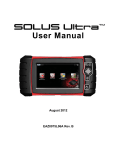

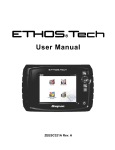
![VERUS PRO User Manual [3980kb PDF File] - Snap](http://vs1.manualzilla.com/store/data/005690474_1-9ff68923f14d7698ce72469cabae3990-150x150.png)


